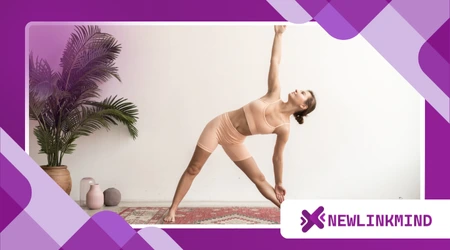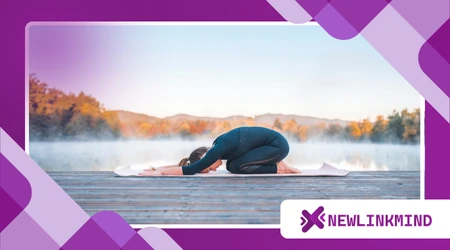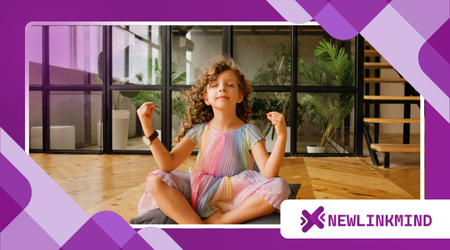Yoga para principiantes: 10 posturas sencillas para practicar en casa

Anuncios
Yoga para principiantes es más que una idea de autocuidado de moda: es una forma poderosa y accesible de calmar la mente, estirar el cuerpo y reconectarse con uno mismo, una respiración a la vez.
Si alguna vez has sentido que el yoga es demasiado avanzado, demasiado espiritual o inalcanzable, esta guía es para ti. No necesitas flexibilidad, equipo caro ni una membresía de estudio para empezar. Solo un espacio tranquilo, una esterilla o toalla, y la voluntad de asistir, de forma imperfecta, constante y suave.
Este artículo lo guiará a través de los principales beneficios del yoga, le ofrecerá 10 posturas aptas para principiantes que puede practicar en casa y compartirá estrategias para crear una rutina sustentable y espiritual, además de responder preguntas frecuentes con claridad y honestidad.
Tabla de contenido
- ¿Por qué empezar con el yoga?
- Los beneficios mentales y físicos
- 10 posturas sencillas que puedes practicar hoy
- Construyendo un espacio consciente en casa
- Creando una rutina que perdure
- Consejos para mantener la constancia
- Reflexiones finales y recursos
- Preguntas frecuentes
¿Por qué empezar con el yoga?
En un mundo que nunca se detiene, elegir la quietud parece casi rebelde. Yoga para principiantes Ofrece esa rebeldía: un respiro del desorden mental, la rigidez física y la desconexión emocional. Es una puerta a la presencia.
Anuncios
Actualmente, más de 300 millones de personas practican yoga en todo el mundo y solo en Estados Unidos se ha registrado un aumento del 21% en nuevos practicantes desde 2023, según Statista.
Detrás de esta tendencia hay un cambio: la gente ya no busca intensidad, sino sostenibilidad.
A diferencia de las rutinas de fitness de alto rendimiento, el yoga no te exige esforzarte más. Te invita a escuchar con más atención.
Anuncios
Para sintonizar, no desconectar. No necesitas abdominales marcados; necesitas consciencia.
¿Alguna vez te has preguntado qué tan diferente sería tu día si tu primera acción no fuera tomar tu teléfono, sino respirar profundamente con intención?

Los beneficios mentales y físicos
La efectividad del yoga va mucho más allá de lo visible. A nivel físico, aumenta la flexibilidad, mejora la postura y fortalece los músculos estabilizadores que a menudo se pasan por alto.
Pero sus beneficios mentales son donde comienza la magia.
Un estudio de 2024 de la Facultad de Medicina de Harvard descubrió que sólo 15 minutos de yoga diarios Redujo significativamente los niveles de cortisol (la hormona del estrés) y mejoró la variabilidad de la frecuencia cardíaca y la calidad del sueño. Eso es menos tiempo que una pausa para el café, con beneficios exponencialmente mayores.
El yoga también activa el sistema nervioso parasimpático, responsable de la respuesta de descanso y digestión. A medida que el estrés se vuelve crónico en el estilo de vida de la era digital, esta activación puede cambiar la vida.
No es sólo anecdótico.
Una diseñadora de UX de Portland compartió cómo dos semanas de yoga diario al mediodía la ayudaron a reducir los dolores de cabeza, dormir mejor e incluso mejorar su desempeño laboral.
Ella no presionó más, se ablandó y allí encontró fuerza.
¿Y físicamente? Incluso las posturas suaves pueden aliviar la ciática, aliviar los problemas digestivos y reducir el dolor lumbar crónico, todos comunes entre los trabajadores de oficina o los mayores de 40 años.
Leer más: Mantras matutinos fáciles para comenzar el día con intención
10 posturas sencillas que puedes practicar hoy
Estas posturas, ideales para principiantes, no requieren equipo: solo atención, respiración y cuerpo. Son accesibles para casi todas las edades y complexiones.
1. Postura de la montaña (Tadasana)
Ponte de pie, con los pies separados a la anchura de las caderas. Presiona los pies contra el suelo, levanta el pecho y estira la cabeza. Siente la conexión entre la fuerza y la calma.
2. Postura del niño (Balasana)
Arrodíllate y dóblate hacia adelante, apoyando la frente en la colchoneta. Este es tu botón de reinicio: te conecta a tierra y te calma emocionalmente. Ideal para cuando la ansiedad te invade.
3. Perro boca abajo (Adho Mukha Svanasana)
Crea una V invertida con el cuerpo. Flexiona las rodillas según sea necesario. Esta postura estira la columna vertebral, energiza el cerebro y estira la espalda.
4. Postura del gato y la vaca
A gatas, inhale en postura de Vaca (arqueando la espalda) y exhale en postura de Gato (columna vertebral curvada). Este movimiento rítmico sincroniza la respiración y ayuda a liberar la tensión emocional acumulada en la columna vertebral.
5. Flexión hacia adelante sentada (Paschimottanasana)
Siéntate con las piernas extendidas. Inclínate hacia adelante, alcanzando los pies. Aunque tus manos solo toquen las rodillas, estás haciendo el trabajo: relajando los isquiotibiales y calmando el sistema nervioso.
6. Postura del puente
Acuéstese boca arriba, con las rodillas flexionadas y los pies apoyados en el suelo. Levante las caderas lentamente. Esto fortalece los glúteos y la espalda, a la vez que abre suavemente el pecho y el corazón.
7. Postura del árbol (Vrksasana)
Ponte de pie, transfiere el peso a una pierna y coloca el otro pie sobre la parte interna del muslo o la pantorrilla. Equilibra, tambalea, sonríe. Enseña concentración, humildad y resiliencia.
8. Postura de la cobra
Acuéstate boca abajo, coloca las manos bajo los hombros. Inhala, presiona ligeramente el suelo y eleva el pecho. Esto abre los pulmones y fortalece la espalda.
++ ¿Meditar antes del café? ¿Por qué podría ser revolucionario?
9. Giro supino
Acostado boca arriba, abrace una rodilla contra el pecho y luego llévela por el cuerpo. Una suave desintoxicación espinal y un masaje para los órganos internos.
10. Savasana
Acuéstate boca arriba, con los brazos relajados. Libera todo esfuerzo. Esto no es solo descansar, es donde se produce la integración. Un ritual de liberación y absorción.
Construyendo un espacio consciente en casa
Uno de los regalos más hermosos del yoga es que no requiere un entorno específico. Un rincón dedicado, una iluminación suave y quizás una vela pueden hacer maravillas con tu motivación.
No hace falta replicar un estudio. Simplemente busca un espacio que te indique que "este es tu momento". Deja tu tapete desenrollado, ten una planta cerca o usa aromas relajantes como la lavanda para crear una señal sensorial.
Desactivar las notificaciones y pisar descalzo el tapete crea un espacio sagrado, incluso en un apartamento ruidoso. La simplicidad es la invitación.

Creando una rutina que perdure
Las rutinas fracasan cuando son demasiado ambiciosas. Olvídate de las sesiones de una hora. Empieza con diez minutos. Vincula tu práctica con algo habitual: justo después de cepillarte los dientes o antes de cenar.
Un padre soltero de Brooklyn empezó a practicar secuencias cortas con su hija de 7 años todos los domingos. Se convirtió en su ritual sin tecnología: solo movimiento, risas y presencia. Su constancia no se basaba en la disciplina, sino en la recompensa emocional.
Deja que tu práctica evolucione con tu horario. Algunos días fluirás, otros descansarás. Lo único malo es no empezar.
Consejos para mantener la constancia
Mantenerse constante con su práctica no se trata de una disciplina rígida, se trata de crear hábitos que resulten gratificantes.
Cuando el yoga se convierte en un momento de paz, no de presión, naturalmente encuentra espacio en tu rutina.
En lugar de guardar el tapete fuera de la vista, intenta dejarlo desenrollado en un lugar visible.
Esta sutil señal le recuerda a tu cerebro: Se permite hacer una pausa, aunque sea solo por cinco minutos.
Combina tu práctica con un hábito que ya tengas.
Ya sea justo después de cepillarse los dientes o justo antes de la cena, esta “acumulación de hábitos” convierte al yoga en una extensión natural de su día.
Observa cómo te sientes después de cada sesión. Lleva un pequeño cuaderno o diario digital. Reflexionar sobre tu energía, tu sueño o tus emociones crea un vínculo más profundo entre tu cuerpo y tu compromiso.
Elige una guía o plataforma de confianza. Recursos como Revista de yoga Ofrecemos programas estructurados para principiantes que reducen la fatiga de decisiones, para que usted pueda concentrarse en presentarse, no en elegir qué hacer.
Acepta la imperfección. Algunos días fluirás con concentración, otros permanecerás en la Postura del Niño todo el tiempo. Eso sigue siendo práctica. Lo importante es presentarse con honestidad, no con maestría.
Recompénsate. No con golosinas, sino con reconocimiento. Anótalo en tu calendario, enciende una vela después o simplemente di "gracias" en voz alta. Estos rituales refuerzan el valor de lo que haces.
Cuando el yoga se siente como un refugio en lugar de una responsabilidad, la constancia se convierte en un subproducto, no en una batalla.
Preguntas frecuentes
1. ¿Necesito ser flexible para empezar a practicar yoga?
No. La flexibilidad se desarrolla con la práctica. El yoga te acompaña donde sea que estés, sin expectativas ni juicios.
2. ¿Cuál es el mejor momento del día para practicar?
El mejor momento es aquel al que siempre regresas. Las mañanas te llenan de energía; las tardes te revitalizan. Escucha tu ritmo natural.
3. ¿Puedo practicar yoga si tengo lesiones?
Sí, pero modifica las posturas. Concéntrate en la respiración y la alineación. Consulta con un profesional de la salud o un instructor certificado para obtener orientación personalizada.
4. ¿El yoga es un entrenamiento o una práctica de atención plena?
Es ambas cosas. El yoga mejora la fuerza y la movilidad, pero también reduce la ansiedad, aumenta la consciencia y centra las emociones.
5. ¿Con qué frecuencia debe practicar un principiante?
Intenta hacerlo de 3 a 4 veces por semana. Incluso sesiones de 10 minutos marcan la diferencia si se realizan con regularidad.
6. ¿Necesito accesorios o equipo especial?
Para nada. Una esterilla ayuda, pero puedes usar toallas, libros o cojines para apoyar el cuerpo de forma segura y creativa.
7. ¿Cuánto tiempo hasta que note resultados?
Puede sentirse más tranquilo y centrado en cuestión de días. Los beneficios físicos suelen aparecer entre 2 y 4 semanas después de la aplicación.
++ Una secuencia de yoga matutina de 10 minutos para
10 posturas de yoga para hacer todos los días para principiantes
